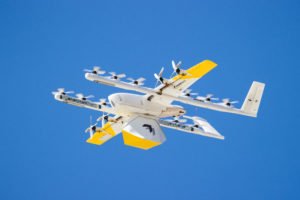 News and Commentary. Today, Wing CEO Adam Woodworth testified before Congress on the need for drone regulations that support commercial operations – and American leadership in the industry.
News and Commentary. Today, Wing CEO Adam Woodworth testified before Congress on the need for drone regulations that support commercial operations – and American leadership in the industry.
In his testimony, Woodworth laid out 9 points for Congress to consider in the FAA Reauthorization Bill, a vehicle that allows Congress to influence the activities and goals of the agency.
In an Op-Ed previewing his testimony, published in Aviation Week, Woodworth said that in order to maintain U.S. leadership in the drone industry, the FAA must develop a regulatory framework that is “predictable and pragmatic.” From the Op-Ed:
Above all, we’d like to see Congress assist the FAA in adopting an approach to the safe integration of drones into our national airspace that is two things: predictable and pragmatic.
The FAA is the right regulator for uncrewed aircraft systems, but the agency currently regulates Wing’s 11 lb. foam drones using the same framework that was designed for 400,000 lb. airliners. Many of those regulations make sense for passenger-carrying airplanes, but not for small aircraft with no people onboard.
It’s clear that predictability is a necessity for the development of the drone industry. His words are reminiscent of European Commissioner Henrik Hololei, who said during last week’s EASA High Level Conference on drones that a risk-based, predictable framework of regulations would ensure that “The European Union will stay at the forefront of the development of the drone industry…Europe will be an attractive and safe place for drone startups and investment.” In the race to lead the emerging industry, countries and regions are competing for startup investment and innovation on the basis of regulations.
First on Woodworth’s points was BVLOS flight, a long-awaited rulemaking from the FAA. While the FAA has granted a number of waivers to the restriction on flying drones Beyond Visual Line of Sight, Woodworth points out in his Op-Ed that waivers are simply not scalable.
The time of flying by waiver/exemption has been useful, but it’s insufficient to enable the most beneficial uses for drones. As a nation, we need to transition to flying by rule in order to use drones to effectively respond to emergencies, deliver food and medicine to homebound residents, survey infrastructure, and support other commercial drone applications that depend on predictable approval processes.
Other points in Woodworth’s testimony addressed establishing a target for “acceptable level of risk” that would help UAS operators develop appropriate safety cases: “This would add much-needed consistency to the process and reduce the arbitrary subjectivity and excessive delays currently experienced by operators,” said the testimony statement.
UAS Certification, incentives for legacy aircraft to adopt ADS-B technology, UTM, environmental reviews, and the expansion of Remote ID to include Network ID technology were also included in Woodworth’s testimony. And, in a clear call for more targeted support for the drone industry, Woodworth called for “Realignment” within the FAA which would clearly establish new procedures and processes appropriate for uncrewed aircraft and empower the drone industry experts in the organization.
Congress should enable the FAA to take a more direct approach with the hundreds of thousands of new aircraft operators and stakeholders in the NAS, by elevating and empowering the UAS Integration Office to streamline and improve existing approval processes within the FAA’s organizational structure.
Specifically, Congress should include language in the FAA reauthorization to create a position of Associate Administrator to oversee UAS operations and certification, and provide that person with the authority to actually approve UAS and their operations, while ensuring appropriate consultation with other lines of business within the FAA.
In his testimony statement, Woodworth said that Wing – and other domestic drone companies – need a regulatory framework that will support their scale here in the U.S.
Wing has invested an incredible amount of time, brain power, and resources into developing and proving out a system that is capable of serving millions of customers in populated areas across the globe. We are anxious to see the FAA adopt a regulatory framework that will enable us to bring the benefits of this promising technology to communities across the country and maintain our leadership in the field of emerging aviation technology.
Read more:
- Wing Launches the Automated Wing Delivery Network, with Autoloader for Curbside Pickup [VIDEOS]
- Wing Drone Delivery in Texas Starts This Week: Walgreens, Texas Health, EasyVet, and Ice Cream
- Wing Drone Delivery in Australia: One Drone Delivery Every 25 Seconds, Commercial Ops at Scale
- DoorDash by Drone: Wing Starts Pilot Program in Australia
Miriam McNabb is the Editor-in-Chief of DRONELIFE and CEO of JobForDrones, a professional drone services marketplace, and a fascinated observer of the emerging drone industry and the regulatory environment for drones. Miriam has penned over 3,000 articles focused on the commercial drone space and is an international speaker and recognized figure in the industry. Miriam has a degree from the University of Chicago and over 20 years of experience in high tech sales and marketing for new technologies.
For drone industry consulting or writing, Email Miriam.
TWITTER:@spaldingbarker
Subscribe to DroneLife here.







[…] More… […]